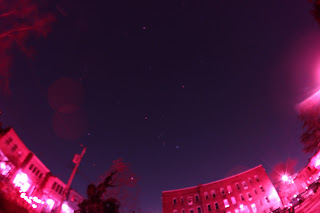I am especially interested in this as I would like to get a decent image of the Orion Constellation with Barnard's Loop, the Flame Nebula, and etc. I attempted this a week ago with partial success in that I did get some of Barnard's Loop, however, light pollution (bad gradient) near the bottom of the image made it impossible to resolve. It may have been do to excessive Christmas light pollution. I want to try this again with no Christmas lights and with the UHC filter but wanted to do a a quick test before I do it for real.
The test was done in downtown Baltimore with heavy light pollution with two lenses. The first test was done with my Opteka 6.5 mm Fisheye lens and the second test was done with my Canon EF 50 mm f/1.8 lens (this is the lens that I want to do the constellation image with). Of course it was slightly out of focus on the UHC image with the fisheye lens.
Opteka Fisheye
Astronomik OWB - 30s, ISO 800
No Filter - 30s, ISO 800
Astronomik UHC - 30s, ISO 800
Canon 50 mm
Astronomik OWB - 10s, ISO 800
No Filter - 10s, ISO 800
Astronomik UHC - 10s, ISO 3200
Processing the image a bit
The results are promising as only the UHC Filter image shows the the Horsehead and Flame Nebula along with the Orion Nebula using the 50 mm lens. The other images only show Orion. The ISO was set at 3200 for the UHC shot, however, non UHC images were white when I set the ISO at 3200.







No comments:
Post a Comment